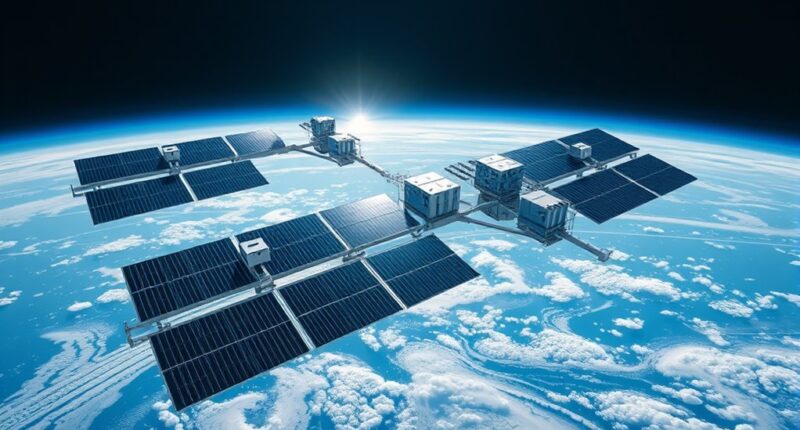New space-based solar power projects are emerging as a promising way to provide reliable, clean energy for millions. By capturing sunlight in orbit, these systems avoid weather and night cycles, offering continuous power. Advances in satellite efficiency and orbit optimization mean we can generate more energy with fewer satellites. Innovations in propulsion and station-keeping make maintenance cost-effective, boosting long-term output. If you want to explore how these developments could impact global energy, there’s more to uncover.
Key Takeaways
- New SBSP projects aim to deploy advanced, high-efficiency solar panels in space for continuous energy capture.
- Innovations focus on orbit optimization to maximize sunlight exposure and reduce transmission losses.
- Emerging propulsion and station-keeping technologies enhance satellite lifespan and operational efficiency.
- These projects aim to scale up power transmission, potentially supplying electricity to millions globally.
- Space-based solar power offers a sustainable, weather-independent energy source for future large-scale deployment.

Have you ever wondered if we could harness the sun’s energy more efficiently? Space-based solar power (SBSP) projects are aiming to do just that by capturing sunlight in space and transmitting it to Earth. Unlike ground-based solar panels, satellites can collect sunlight without weather interruptions or night cycles, making them a promising solution for continuous energy supply. The key to making these projects viable lies partly in improving satellite efficiency and optimizing their orbits. By enhancing satellite efficiency, we can maximize the amount of sunlight they capture and convert into usable energy. This involves developing advanced photovoltaic materials that perform better in the harsh environment of space, allowing satellites to generate more power with less surface area. The better these panels perform, the more energy each satellite can produce, making the entire system more cost-effective and scalable. Additionally, material durability is crucial to ensure long-term operation in the extreme conditions of space.
Orbit optimization is equally critical. Satellites need to be positioned in specific orbits that maximize sunlight exposure and ensure efficient energy transmission back to Earth. Geostationary orbits are popular because they keep the satellite fixed over one spot, simplifying energy transfer. However, researchers are exploring other orbits, like sun-synchronous or elliptical paths, which could offer better coverage or reduce launch costs. Fine-tuning a satellite’s orbit ensures it spends more time collecting sunlight and less time maneuvering, boosting overall satellite efficiency. It also minimizes energy loss during transmission, making the system more reliable and capable of powering millions of homes.
Advancements in orbit optimization also involve using innovative propulsion and station-keeping technologies. These allow satellites to maintain their precise positions with less fuel, reducing operational costs and extending mission lifespans. By carefully planning and adjusting orbits, space-based solar power projects can achieve higher satellite efficiency, leading to increased energy output without requiring more satellites. This strategic positioning helps in providing a steady and abundant flow of solar energy back to Earth, making clean energy more accessible and sustainable.
Frequently Asked Questions
How Long Will It Take to Implement These Space-Based Solar Projects?
You might wonder how long it’ll take to implement these space-based solar projects. It depends on launch logistics and technological readiness; these factors influence development and deployment speed. Currently, experts estimate it could take 10 to 20 years to move from concept to operational systems. You’ll need patience as engineers refine launch strategies, improve technology, and address safety concerns before these projects can start powering millions.
What Are the Main Environmental Concerns Associated With Space Solar Power?
You should consider that space solar power raises environmental concerns like space radiation, which can affect both satellites and spacecraft, and satellite contamination, leading to debris buildup in Earth’s orbit. These issues could impact other space activities and pose risks for future missions. Managing space debris and minimizing radiation exposure are essential to guarantee the sustainable development of space-based solar power without harming the space environment.
How Will Space Debris Impact Satellite-Based Solar Panels?
Ever wonder how space debris could threaten satellite-based solar panels? It’s a real concern because space debris increases collision risks, damaging or destroying your solar arrays. Without proper satellite maintenance, debris can accumulate, making the orbital environment more hazardous. This could lead to costly repairs and reduced power generation. Staying vigilant about space debris and investing in effective satellite maintenance guarantees your solar power system stays operational and safe.
What Are the Estimated Costs for Developing These Projects?
You should know that the cost estimates for developing space-based solar power projects vary widely, often running into billions of dollars. Funding challenges are significant, as they require substantial investment from governments or private sectors. These projects demand advanced technology, extensive infrastructure, and international cooperation, which add to overall expenses. While promising, the high costs make securing consistent funding a critical hurdle for turning these projects into reality.
How Will These Projects Affect Global Energy Markets?
Oh, what a surprise—space projects shaking up the energy market! As these space-based solar projects come online, you’ll see the space market grow, and energy pricing might drop, making electricity more affordable. This innovation could force traditional energy sources to compete with a virtually endless solar supply from space. So, get ready for a new energy era, where your bills could finally reflect the universe’s generosity.
Conclusion
Imagine harnessing the sun’s endless energy from the silent depths of space, turning distant rays into a beacon of hope for millions. These space-based solar power projects are like celestial bridges, connecting us to a future where energy flows as freely as starlight. By embracing this innovation, you’re not just powering homes—you’re igniting a cosmic dance of sustainable possibility, proving that even in the vastness of space, humanity’s brightest ideas can light the way forward.










